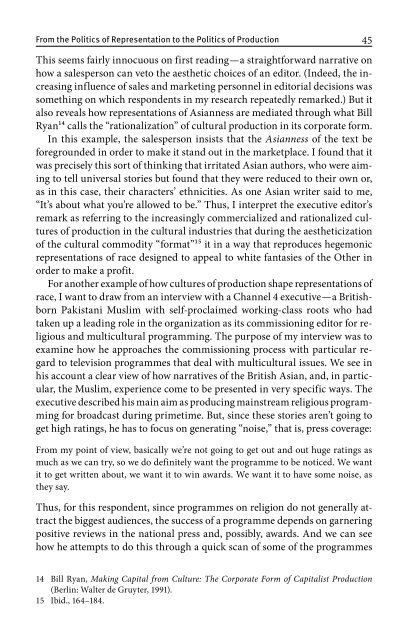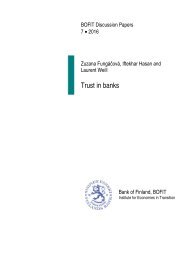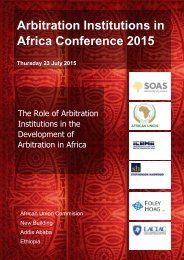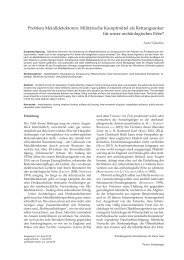Media and Minorities
9783666300882_ruhrmann_media_ebook_034247
9783666300882_ruhrmann_media_ebook_034247
You also want an ePaper? Increase the reach of your titles
YUMPU automatically turns print PDFs into web optimized ePapers that Google loves.
From the Politics of Representation to the Politics of Production 45<br />
This seems fairly innocuous on first reading — a straightforward narrative on<br />
how a salesperson can veto the aesthetic choices of an editor. (Indeed, the increasing<br />
influence of sales <strong>and</strong> marketing personnel in editorial decisions was<br />
something on which respondents in my research repeatedly remarked.) But it<br />
also reveals how representations of Asianness are mediated through what Bill<br />
Ryan14 calls the “rationalization” of cultural production in its corporate form.<br />
In this example, the salesperson insists that the Asianness of the text be<br />
foregrounded in order to make it st<strong>and</strong> out in the marketplace. I found that it<br />
was precisely this sort of thinking that irritated Asian authors, who were aiming<br />
to tell universal stories but found that they were reduced to their own or,<br />
as in this case, their characters’ ethnicities. As one Asian writer said to me,<br />
“It’s about what you’re allowed to be.” Thus, I interpret the executive editor’s<br />
remark as referring to the increasingly commercialized <strong>and</strong> rationalized cultures<br />
of production in the cultural industries that during the aestheticization<br />
of the cultural commodity “format”15 it in a way that reproduces hegemonic<br />
representations of race designed to appeal to white fantasies of the Other in<br />
order to make a profit.<br />
For another example of how cultures of production shape representations of<br />
race, I want to draw from an interview with a Channel 4 executive — a Britishborn<br />
Pakistani Muslim with self-proclaimed working-class roots who had<br />
taken up a leading role in the organization as its commissioning editor for religious<br />
<strong>and</strong> multicultural programming. The purpose of my interview was to<br />
examine how he approaches the commissioning process with particular regard<br />
to television programmes that deal with multicultural issues. We see in<br />
his account a clear view of how narratives of the British Asian, <strong>and</strong>, in particular,<br />
the Muslim, experience come to be presented in very specific ways. The<br />
executive described his main aim as producing mainstream religious programming<br />
for broadcast during primetime. But, since these stories aren’t going to<br />
get high ratings, he has to focus on generating “noise,” that is, press coverage:<br />
From my point of view, basically we’re not going to get out <strong>and</strong> out huge ratings as<br />
much as we can try, so we do definitely want the programme to be noticed. We want<br />
it to get written about, we want it to win awards. We want it to have some noise, as<br />
they say.<br />
Thus, for this respondent, since programmes on religion do not generally attract<br />
the biggest audiences, the success of a programme depends on garnering<br />
positive reviews in the national press <strong>and</strong>, possibly, awards. And we can see<br />
how he attempts to do this through a quick scan of some of the programmes<br />
14 Bill Ryan, Making Capital from Culture: The Corporate Form of Capitalist Production<br />
(Berlin: Walter de Gruyter, 1991).<br />
15 Ibid., 164–184.







